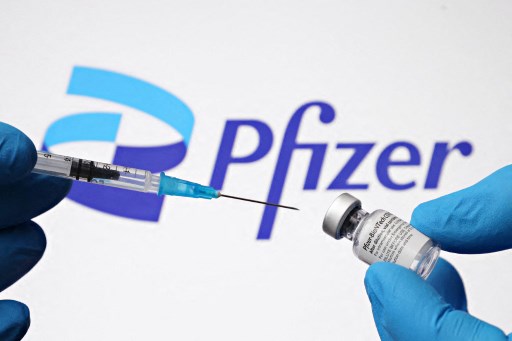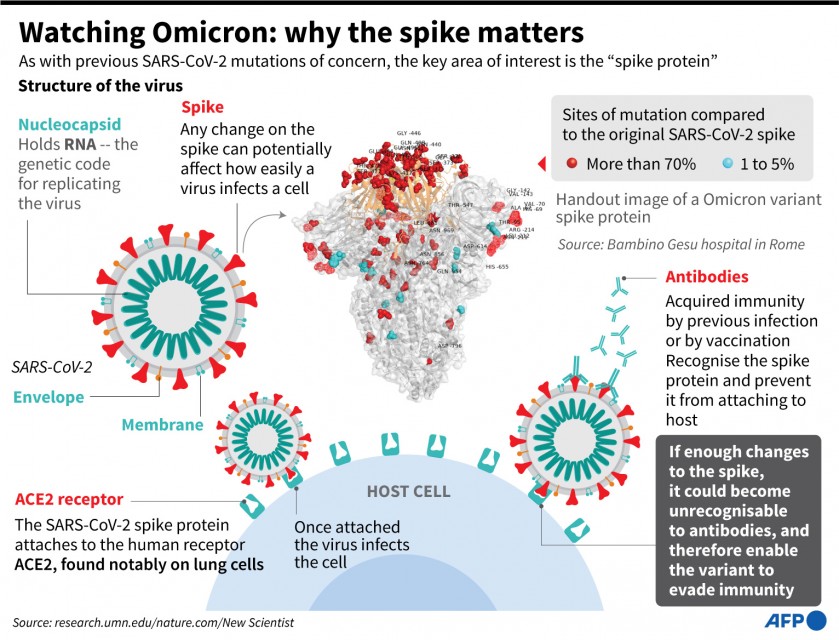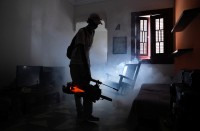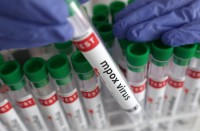
by Sebastien ASH
FRANKFURT, Germany (AFP) — Two doses of the BioNTech and Pfizer coronavirus vaccine may not be enough to protect against the Omicron strain, the companies warned Wednesday, but they stressed it was “still effective” after a third jab.
The companies’ news was called reassuring by experts, and came as the first independent data from labs around the world emerged, suggesting that the new variant is better at evading vaccine-trained immunity than those before it.
In preliminary results published on Wednesday, Pfizer and BioNTech said their vaccine “is still effective in preventing Covid-19, also against Omicron, if it has been administered three times”.
But they warned that “the Omicron variant is probably not sufficiently neutralised after two doses.”
According to early laboratory research using blood serum from vaccinated people, a booster third dose generated around the same level of antibodies against Omicron as is seen after a second dose with the initial strain.
Blood samples from around 20 people who had received two doses of the current vaccine showed on average a 25-fold reduction in neutralising antibodies compared to the early strain of the virus, the companies said.
But they added that another part of the immune response — from T cells — were probably still effective against the variant, adding that “vaccinated individuals may still be protected against severe forms of the disease”.
Their results have not been peer reviewed.
“We still need to be very measured and take a wait and see approach, but I think what we do have is at least encouraging,” Virologist Angela Rasmussen of Canada’s Vaccine and Infectious Disease Organization told AFP.
“Boosters will definitely be helpful in keeping the rate of Omicron breakthrough slower,” she added.
Boosters urged
WHO chief Tedros Adhanom Ghebreyesus on Wednesday summarized what is so far known about Omicron — it poses higher infection risks to people who have already had the virus or been vaccinated than previous variants, and there is a preliminary indication it could cause milder disease.
But even if confirmed to be less severe, the variant is likely even more transmissible than Delta, meaning it could reach and thus sicken more people.
Speaking at a press conference, BioNTech CEO Ugur Sahin said that reducing the time required between second and third doses of the vaccine was the “right way to go” to increase protection through the winter.
The United Kingdom has begun giving booster shots to individuals at least three months after their second dose, while the delay to receive an additional shot is longer elsewhere.
The vaccine-makers said that an Omicron-specific version of the jab, currently in development by BioNTech, would be ready for delivery by March, pending regulatory approval.
The decision to switch production to the tailored vaccine would depend on Omicron’s spread.
Emerging evidence
The announcement comes after other preliminary results from a small study in South Africa suggested there was up to a forty-fold drop in the ability of the antibodies from the Pfizer-BioNTech vaccine to neutralise Omicron, compared to an earlier strain.

The results suggest “that there is definitely much less neutralisation against Omicron compared to neutralisation against the original strains that came out of Wuhan initially,” said Willem Hanekom, executive director of the Africa Health Research Institute, which carried out the study.
But he cautioned that it was important to be “extraordinarily careful” interpreting the results because they only reflect a laboratory setting, while real world data was the true test.
Antibody reductions were also seen in a German study and one carried out in Sweden, but they varied in precise magnitude.
Omicron counts more than 30 mutations on the spike protein that dots the surface of the coronavirus and allows it to invade cells, and a high degree of immune evasion was widely anticipated.
But Rasmussen said she was encouraged by a finding in the South African research that showed the Omicron variant used the same “receptor” — known as ACE2 — to enter cells, as opposed to mutating in a more fundamental way.
The detection of the first Omicron cases two weeks ago coincided with soaring infection numbers across the world, and the variant added fuel to concerns about a global Covid resurgence.
Dozens of nations have re-imposed border restrictions in response to the spread of the new virus variant and raised the possibility of a return of economically punishing lockdowns.
© Agence France-Presse








